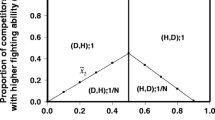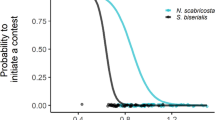Abstract
Game-theory models predict that the frequency and type of agonistic interactions should vary with the value of the resource being contested. We describe bill duels and overt fighting in male Magellanic penguins (Spheniscus magellanicus) at a breeding colony and determine whether these behaviors change with the value of the nests over which they interact. Bill duels represent low levels of aggression while overt fighting high levels of aggression. Consistent with predictions, overt fighting was more common before egg laying when nests have the highest potential value while bill duels were more common at failed nests later in the season when nests are less valuable as they could not be used for reproduction until the next season. Contrary to expectations, overt fights were shorter and resulted in fewer cuts before egg laying than after egg laying. Large size asymmetries between opponents before egg laying may enable losers to quickly assess their opponents and leave before they are hurt. As predicted, the duration and damage occurring during overt fights were positively correlated with nest cover, which is correlated with higher reproductive success. We conclude that male Magellanic penguins have rules of engagement that in the most cases follow game-theory predictions on when and how to interact.


Similar content being viewed by others
References
Björklund M (1989) Male contests in the scarlet rosefinch (Carpodacus erythrinus) in relation to asymmetries in resource holding power and pairing status. Behav Ecol Sociobiol 30:53–58
Boersma PD (1974) The Galapagos penguin: adaptations for life in an unpredictable environment. PhD Dissertation, Ohio State University
Boersma PD (1977) An ecological and behavioral study of the Galapagos penguin. Living Bird 15:43–93
Boersma PD, Davies EM (1987) Sexing monomorphic birds by vent measurements. Auk 104:770–783
Boersma PD, Stokes DL, Yorio PM (1990) Reproductive variability and historical change of Magellanic penguins (Spheniscus magellanicus) at Punta Tombo, Argentina. In: Davis LS, Darby JT (eds) Penguin biology. Academic, San Diego, pp 15–43
Brodsky LM, Montgomerie RD (1987) Asymmetrical contests in defence of rock ptarmigan territories. Behav Ecol Sociobiol 21:267–272
Catterall CP (1989) The economics of winter fighting in silvereyes. Emu 89:173–176
Foster WA (1996) Duelling aphids: intraspecific fighting in Astegopteryx minuta (Homoptera: Hormaphididae). Anim Behav 51:645–655
Gabor CR, Jaeger RG (1995) Resource quality affects the agonistic behaviour of territorial salamanders. Anim Behav 49:71–79
Hammerstein P (1981) The role of asymmetries in animal contests. Anim Behav 29:193–205
Hammerstein P, Parker GA (1982) The asymmetric war of attrition. J Theor Biol 96:647–682
Hodge MA, Uetz GW (1995) A comparison of agonistic behaviour of colonial web-building spiders from desert and tropical habitats. Anim Behav 50:963–972
Itzkowitz M (1979) Territorial tactics and habitat quality. Am Nat 114:585–591
Maynard Smith J, Parker GA (1976) The logic of asymmetric contests. Anim Behav 24:159–175
Molina-Borja M, Padron-Fumero M, Alfonso-Martín T (1998) Morphological and behavioural traits affecting the intensity and outcome of male contests in Gallotia galloti galloti (Family Lacertidae). Ethology 104:314–322
Parker GA, Rubenstein DI (1981) Role assessment, reserve strategy, and acquisition of information in asymmetric animal conflicts. Anim Behav 29:221–240
Powers DR (1989) Effects of variation in food quality on the breeding territory of the Anna’s hummingbird. Condor 89:103–111
Renison D (2000) Magellanic penguin (Spheniscus magellanicus) aggressive behavior: an ecological approach. PhD Dissertation, University of Córdoba
Renison D, Boersma PD, Martella MB (2002) Winning and losing: causes for variability in outcome of fights in male Magellanic penguins (Spheniscus magellanicus). Behav Ecol 13:462–466
Renison D, Boersma PD, Martella MB (2003) Fighting in female Magellanic penguins: when, why and who wins? Wilson Bull 115:58–63
Robinson SK (1985) Fighting and assessment in the yellow-rumped cacique (Cacicus cela). Behav Ecol Sociobiol 18:39–44
Scolaro JA, Hall MA Ximenez IM (1983) The Magellanic penguin (Spheniscus magellanicus): sexing adults by discriminant analysis of morphometric characters. Auk 100:221–224
Smith IP, Huntingford FA, Atkinson RJ, Taylor AC (1994) Strategic decisions during agonistic behaviour in the velvet swimming crab, Necora puber (L.). Anim Behav 47:885–894
Spurr EB (1974) Individual differences in aggressiveness of Adélie penguins. Anim Behav 22:611–616
Stokes DL, Boersma PD (1998) Nest-site characteristics and reproductive success in Magellanic penguins (Spheniscus magellanicus). Auk 115:34–49
Stokes DL, Boersma PD (2000) Nesting density and reproductive success in a colonial seabird, the Magellanic penguin. Ecology 81:2878–2891
Turner GF (1994) The fighting tactics of male mouthbrooding cichlids: the effects of size and residency. Anim Behav 47:655–662
Waas JR (1990) Intraspecific variation in social repertoires: evidence from cave- and burrow-dwelling little blue penguins. Behaviour 115:63–99
Waas JR (1991) Do little blue penguins signal their intentions during aggressive interactions with strangers? Anim Behav 41:375–382
Whitehouse MEA (1997) Experience influences male-male contests in the spider Argyrodes antipodiana. (Theridiidae: Araneae). Anim Behav 53:913–923
Williams TD (1995) Bird families of the world The penguins (Sphenicidae). Oxford University Press, New York pp 288
Acknowledgements
We thank Gisela Giussi, Gustavo Zamora, and Julio Vianna for helping with the fieldwork. We also thank Ana Cingolani, Alan Clark, Sue Moore, Joaquín Navarro, and two anonymous reviewers for suggestions that improved the manuscript. The research was funded by the Wildlife Conservation Society, USA, and made possible by a joint agreement between the Society and Organismo Provincial de Turismo, Chubut, Argentina. D. Renison was supported by Penguin Fund, Japan, and a doctoral fellowship from the Secretaría de Ciencia y Técnica, National University of Córdoba, Argentina.
Author information
Authors and Affiliations
Corresponding author
About this article
Cite this article
Renison, D., Boersma, P.D., Van Buren, A.N. et al. Agonistic behavior in wild male Magellanic penguins: when and how do they interact?. J Ethol 24, 189–193 (2006). https://doi.org/10.1007/s10164-005-0180-4
Received:
Accepted:
Published:
Issue Date:
DOI: https://doi.org/10.1007/s10164-005-0180-4




